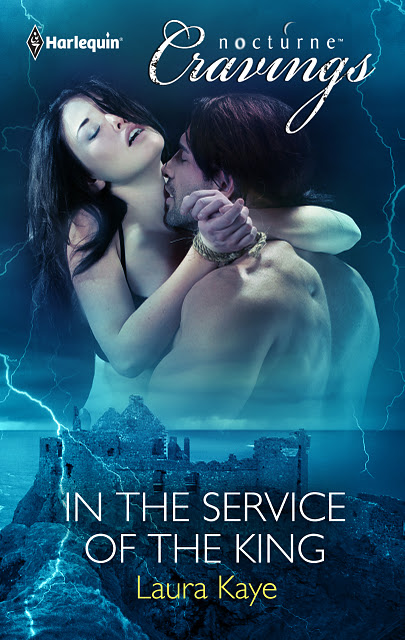What Do Women Want? Romance Novels Tell it All (2008)
Vampire + Castle + Rope = ♥

from
- New Cover Goodness! #Vampire + Castle + Rope = Woot!
- By Laura Kaye.
http://laurakayeauthor.blogspot.com/2011/12/new-cover-goodness-vampire-castle-rope.html
Here's the blurb:
Kael the Fair, one of seven reigning vampire warrior kings, loathes the Night of the Proffering — the night he must feed from a human female virgin to maintain his immortality and his humanity. By feeding directly from the veins of the Proffered as he takes her virginity, Kael could determine whether the mating bond exists between them — but war and a previous loss lead the king to refuse to take a mate. Groomed for the Proffering, twenty-year-old Shayla McKinnon risks her promising academic career to make two other dreams come true — vengeance for her sister's murder at the hands of the evil Soul Eaters and the impossible goal of capturing the Warrior King's heart. In the feeding chamber this night, a battle of wills ensues, one played out through a game of domination and submission that might prove dangerous to both of their hearts.
Xah's analysis:
- It's not just a powerful man, but the most powerful — a King!
- It's not just powerful, but a young, virile, hunk — a warrior king!
- It's not just a warrior king, but posseses magical powers — vampire warrior king!
- He is not some creepy lonewolf, but a respected, elite, leader — one of seven — reigning vampire warrior king!
This man, feeds AND copulates virgins. He had plenty, but is still looking for that One. Comes the heroine: a 20 years old girl. She, a loving yet able woman (YOU), wants this man not just for justice of her sister, but also wants to win his heart!
Bodice-ripper
Some Wikipedia highlight on Romance novel. (aka Bodice-ripper)
A romance novel is a literary genre developed in Western culture, mainly in English-speaking countries. Novels in this genre place their primary focus on the relationship and romantic love between two people, and must have an “emotionally satisfying and optimistic ending.” …
The genre continued to be popular into the twentieth century. In 1919, E.M. Hull's novel The Sheik was published in the United Kingdom. The novel, which became hugely popular, was adapted into a movie, which established star Rudolf Valentino as the top male actor of the time. The hero of this book was an iconic alpha male who kidnapped the heroine and won her admiration through his forceful actions. The novel was one of the first to introduce the rape fantasy. …
The modern romance genre was born in 1972 with Avon's publication of Kathleen Woodiwiss's The Flame and the Flower, the first romance novel “to [follow] the principles into the bedroom.”…
The success of these novels prompted a new style of writing romance, concentrating primarily on historical fiction tracking the monogamous relationship between a helpless heroines and the hero who rescued her, even if he had been the one to place her in danger.[6] The covers of these novels tended to feature scantily clad women being grabbed by the hero, and caused the novels to be referred to as “bodice-rippers.”[66] A Wall St. Journal article in 1980 referred to these bodice rippers as “publishing's answer to the Big Mac: They are juicy, cheap, predictable, and devoured in stupifying quantities by legions of loyal fans.”[70] The term bodice-ripper is now considered offensive to many in the romance industry.[66]
In this new style of historical romance, heroines were independent and strong-willed and were often paired with heroes who evolved into caring and compassionate men who truly admired the women they loved.[71] This was in contrast to the contemporary romances published during this time, which were often characterized by weak females who fell in love with overbearing alpha males.[72] Although these heroines had active roles in the plot, they were “passive in relationships with the heroes.”[73] Across the genre, heroines during this time were usually aged 16 to 21, with the heroes slightly older, usually around 30. The women were virgins, while the men were not, and both members of the couple were described as beautiful.[74]
By the 2000s, romance had become the most popular genre in modern literature. In 2004, romantic fiction generated $1.2 billion in sales, with 2,285 romance novels published. Almost 55% of all paperback books sold in 2004 were romance novels, and this genre made up 39% of all fiction sold that year. Over 64 million people claimed to have read at least one romance novel in 2004, according to a Romance Writers of America study, a 26% increase over their 2001 study. Twenty-two percent of romance readers identified themselves as male, and the romance readers were split evenly between people who were married and those who were single. People of all ages read romance novels, with one percent of readers younger than 13, and forty-two percent of them have at least a bachelor's degree.
- Anne Rice's Vampire
- Discovering Twilight Dawn Reaction
- the Female Mentality (2003)
- What Is Gender Feminism (2004)
- ABBA - “Take a Chance on Me” Courtship Dissected
- a Choker Romance
- Midnight Poison - Space Dementia 🎵
- Fashion Alice (Haute Couture)
- Chick Porn: 50 Shades of Grey
- What Do Women Want in a Date? Billion Dollars Market Research Tells